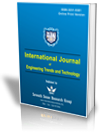Quantitative-Comparative Analysis of the Microscopic Changes of the Use of Sandblasting with 50 μm and 110 μm Aluminum Oxide Particles at the Base of the Brackets
Quantitative-Comparative Analysis of the Microscopic Changes of the Use of Sandblasting with 50 μm and 110 μm Aluminum Oxide Particles at the Base of the Brackets |
||
 |
 |
|
| © 2025 by IJETT Journal | ||
| Volume-73 Issue-4 |
||
| Year of Publication : 2025 | ||
| Author : Liz Flores-Osorio, Jorge Infantes-Vargas, Sandra Pastor-Arenas, Oscar Alcazar-Aguilar, Alicia Alva-Mantari, Gina Leon-Untiveros |
||
| DOI : 10.14445/22315381/IJETT-V73I4P109 | ||
How to Cite?
Liz Flores-Osorio, Jorge Infantes-Vargas, Sandra Pastor-Arenas, Oscar Alcazar-Aguilar, Alicia Alva-Mantari, Gina Leon-Untiveros, "Quantitative-Comparative Analysis of the Microscopic Changes of the Use of Sandblasting with 50 μm and 110 μm Aluminum Oxide Particles at the Base of the Brackets," International Journal of Engineering Trends and Technology, vol. 73, no. 4, pp. .92-103, 2025. Crossref, https://doi.org/10.14445/22315381/IJETT-V73I4P109
Abstract
The objective of this study was to compare the microscopic changes in the base of the brackets after sandblasting with 50 μm and 110 μm aluminum oxide particles (Al2O3). Methods: The sample of this study will be made up of 60 premolar teeth that were extracted for orthodontic purposes; metal premolar brackets (Roth 0.022) were used in the brand GC Orthodontics Axcess. 2 groups of 30 brackets were divided and adhered to the vestibular surface of the teeth of the entire sample, the adhesion was photopolymerized using an LED lamp for 10 seconds in each bracket. The first group was sandblasted with 50-micron aluminum oxide. The first shear was then performed, and the second shear was performed after one week. The other group of brackets was sandblasted with 110 μm aluminum oxide. Data were analyzed using descriptive statistics, ANOVA, and tests. The mesh of the brackets was evaluated with the adhesive residue index using a stereoscopic microscope with 10X magnification.
Keywords
Bracket, Sandblasting, Aluminum oxide, Surface Treatment, Orthodontic Brackets.
References
[1] André-Luiz-Campos dos Santos et al., “Orthodontic Bracket Bonding Techniques and Adhesion Failures: A Systematic Review and Meta-Analysis,” Journal of Clinical and Experimental Dentistry, vol. 14, no. 9, pp. e746-e755, 2022.
[CrossRef] [Google Scholar] [Publisher Link]
[2] Nicole Carolina Pazmiño García, and Luis Alberto Vallejo Izquierdo, “Comparative Study of Adhesion between Perforated Bracket Bases and Premolar Mesh. In Vitro Study,” Knowledge Pole, vol. 7, no. 9, pp. 2468-2482, 2022.
[Google Scholar] [Publisher Link]
[3] Mohammad Farahani et al., “Effect of Bracket Base Sandblasting on Bonding of Orthodontic Brackets on Enamel Surface,” Dental Hypotheses, vol. 7, no. 4, pp. 133-136, 2016.
[CrossRef] [Google Scholar] [Publisher Link]
[4] C.C. Sánchez, “Michael G. Buonocore, Father of Modern Adhesive Dentistry, 63 Years of the Development of the Enamel Etching Technique (1955-2018),” ADM Magazine Official Organ of the Mexican Dental Association, vol. 75, no. 3, pp. 135-142, 2018.
[Google Scholar] [Publisher Link]
[5] Thiago Fonseca-Silva et al., “Comparative Analysis of Shear Bond Strength of Steel and Ceramic Orthodontic Brackets Bonded with Six Different Orthodontic Adhesives,” International Journal of Odontostomatology, vol. 14, no. 4, pp. 658-663, 2020.
[CrossRef] [Google Scholar] [Publisher Link]
[6] Alejandra Berenice Garcia Barrera, “Effectiveness of Aluminum Oxide in Resisting Shear Force in Metal Brackets,” Faculty of Medicine, Institutional Repository, pp. 1-37, 2018.
[Google Scholar] [Publisher Link]
[7] Ali H. Alzainal et al., “Orthodontic Bonding: Review of the Literature,” International Journal of Dentistry, vol. 2020, pp. 1-10, 2020.
[CrossRef] [Google Scholar] [Publisher Link]
[8] Naxca Maureen Doty Díaz Azuela, and René García Contreras, “Comparison of the Peel Strength of Metal Brackets Cemented with Transbond or Enlight Resin after Three Months of Exposure to Acidic or Alkaline Viarden Artificial Saliva,” Faculty of Medicine, Institutional Repository, 2021.
[Google Scholar] [Publisher Link]
[9] Naif Almosa, and Hamayun Zafar, “Incidence of Orthodontic Brackets Detachment During Orthodontic Treatment: A Systematic Review,” Pakistan Journal of Medical Sciences, vol. 34, no. 3, pp. 744-750, 2018.
[CrossRef] [Google Scholar] [Publisher Link]
[10] Pierre Dingreville et al., “What are the Risk Factors Specific to Patient for Debonding of Orthodontic Brackets?,” French Orthodontics, vol. 92, no. 4, pp. 391-401, 2021.
[CrossRef] [Google Scholar] [Publisher Link]
[11] Olmedo Aguilar Moreno, “In Vitro Study of the Adhesion Strength of New Metal Brackets and Metal Brackets with Repeated Conditioning Using the Sandblasting Technique Bonded to the Dental Surface,” Masters Thesis, University of Panama, pp. 1-128, 2018.
[Google Scholar] [Publisher Link]
[12] Manuela M. Haro Montero et al., “Comparison of Shear Bond Strength of Brackets Recycled Using Micro Sandblasting and Industrial Methods,” Angle Orthod, vol. 85, no. 3, pp. 461-467, 2015.
[CrossRef] [Google Scholar] [Publisher Link]
[13] Geeta Rao Gupta, “Tackling Pneumonia and Diarrhoea: The Deadliest Diseases for the World’s Poorest Children,” The Lancet, vol. 379, no. 9832, pp. 2123-2124, 2012.
[CrossRef] [Google Scholar] [Publisher Link]
[14] Fatemeh Namvar et al., “Shear Bond Strength of Metallic Orthodontic Brackets to Zirconium Crowns Treated by Sandblasting Compared to Enamel Using a Universal Adhesive: An in Vitro Study,” International Orthodontics, vol. 20, no. 2, 2022.
[CrossRef] [Google Scholar] [Publisher Link]
[15] Esra Buyukcavus, Muhittin Ugurlu, and Muhammed Hilmi Buyukcavus, “Shear Bond Strength of Orthodontic Molar Tubes to Composite Restoration Bonded with Particular Adhesives after Different Surface Pre-Treatments,” Orthodontics & Craniofacial Research, vol. 25, no. 4, pp. 541-548, 2022.
[CrossRef] [Google Scholar] [Publisher Link]
[16] Shiva Alavi et al., “Effect of Different Surface Treatment with Panaviav5 on Shear Bond Strength of Metal Brackets to Silver Amalgam,” Dental Research Journal, vol. 18, no. 1, pp. 1-7, 2021.
[CrossRef] [Google Scholar] [Publisher Link]
[17] Homa Farhadifard et al., “Effect of Different Surface Treatments on Shear Bond Strength of Ceramic Brackets to Old Composite,” Biomaterials Research, vol. 24, no. 1, pp. 1-7, 2020.
[CrossRef] [Google Scholar] [Publisher Link]
[18] González-Luna Pedro IV et al., “Evaluation of the Adhesion Strength of Brackets Reconditioned by Sandblasting, Thermal and Mixed Methods,” Tamé Magazine, vol. 8.9, no. 24, pp. 964-970, 2021.
[Google Scholar] [Publisher Link]
[19] Mônica Schäffer Lopes et al., “The Lingual Enamel Morphology and Bracket Shear Bond Strength Influenced by Nd:YAG Laser and Aluminum Oxide Sandblasting Preconditioning,” Clinical Oral Investigations, vol. 25, no. 3, pp. 1151-1158, 2021.
[CrossRef] [Google Scholar] [Publisher Link]
[20] Abad Bocangel Salcedo-Alcaychahua, Aron Aliaga-Del Castillo, and Luis Ernesto Arriola-Guillén, “Shear Bond Strength at the Resin/Bracket Interface of Sandblasted Brackets with Different Aluminum Oxide Particle Size,” Journal of Orofacial Sciences, vol. 12, no. 1, pp. 24-29, 2020.
[CrossRef] [Google Scholar] [Publisher Link]
[21] Cody C. Oldham et al., “In Vitro Comparison of Shear Bond Strengths of Ceramic Orthodontic Brackets with Ceramic Crowns Using an Aluminium Oxide Air Abrasion Etchant,” International Orthodontics, vol. 18, no. 1, pp. 115-120, 2020.
[CrossRef] [Google Scholar] [Publisher Link]
[22] Kiran Chakravarthula et al., “Recycling of Brackets: Unleashing the Lucid Way,” International Journal of Dental Science and Innovative Research, vol. 2, no. 4, pp. 64-68, 2019.
[Publisher Link]
[23] Hooman Zarif Najafi et al., “Evaluation of The Effect of Different Surface Conditioning Methods on Shear Bond Strength of Metal Brackets Bonded to Aged Composite Restorations,” International Orthodontics, vol. 17, no. 1, pp. 80-88, 2019.
[CrossRef] [Google Scholar] [Publisher Link]
[24] Ricardo Luis Macchi, Dental Materials, Pan American Medical, 2007.
[Google Scholar] [Publisher Link]
[25] C. Urcola, “Comparison of the Bond Strength of Metal Brackets Treated with Different Conditioning Techniques Using Light-Curing Adhesive Systems,” National University of La Plata, pp. 1-123, 2021.
[Google Scholar] [Publisher Link]
[26] Thomas M. Graber, Robert L. Vanarsdall, Lee W. Graber, Orthodontics: Current Principles and Techniques, Barcelona, 2006.
[Google Scholar]
[27] Esequiel E. Rodríguez Yañez et al., Contemporary Orthodontics. Diagnosis and Treatment, 3rd ed., Amolca, 2019.
[Google Scholar] [Publisher Link]
[28] Gonzalo Andrés Garcés et al., “Shear Bond Strength Evaluation of Metallic Brackets Bonded to a CAD/CAM PMMA Material Compared to Traditional Prosthetic Temporary Materials: An in Vitro Study,” Dental Press Journal of Orthodontics, vol. 25, no. 3, pp. 31-38, 2020.
[CrossRef] [Google Scholar] [Publisher Link]
[29] Rami Aboujaoude et al., “Comparison of The Accuracy of Bracket Positioning Between Direct and Digital Indirect Bonding Techniques in the Maxillary Arch: A Three-Dimensional Study,” Progress in Orthodontics, vol. 23, pp. 1-13, 2022.
[CrossRef] [Google Scholar] [Publisher Link]
[30] H. Pamukçu, Ö. Polat Özsoy, and R. Dağalp, “In Vitro and in Vivo Comparison of Orthodontic Indirect Bonding Resins: A Prospective Study,” Nigerian Journal of Clinical Practice, vol. 21, no. 5, pp. 614-623, 2018.
[CrossRef] [Google Scholar] [Publisher Link]
[31] José Antonio Canut Brusola, Clinical and Therapeutic Orthodontics, Elsevier Spain, 2000. [Google Scholar] [Publisher Link] [32] Csaba Dudás et al., “Clinical Bracket Failure Rates Between Different Bonding Techniques: A Systematic Review and Meta-Analysis,” European Journal of Orthodontics, vol. 45, no. 2, pp. 175-185, 2023.
[CrossRef] [Google Scholar] [Publisher Link]
[33] Aurel-Claudiu Vartolomei et al., “Comparative Evaluation of Two Bracket Systems’ Bond Strength: Conventional and Self-Ligating,” Dentistry Journal, vol. 10, no. 10, pp. 1-10, 2022.
[CrossRef] [Google Scholar] [Publisher Link]
[34] Kenan Demirovic et al., “Comparison of Shear Bond Strength of Orthodontic Brackets Using Direct and Indirect Bonding Methods in Vitro and in Vivo,” Medical Informatics Act, vol. 26, no. 2, pp. 125-129, 2018.
[CrossRef] [Google Scholar] [Publisher Link]
[35] Guillermo Grazioli et al., “Residual Adhesive Removal Methods for Rebonding of Debonded Orthodontic Metal Brackets: Systematic Review and Meta-Analysis,” Materials, vol. 14, no. 20, pp. 1-11, 2021.
[CrossRef] [Google Scholar] [Publisher Link]
[36] Purna Prasad Khanal et al., “A Comparative Study on the Effect of Different Methods of Recycling Orthodontic Brackets on Shear Bond Strength,” International Journal of Dentistry, vol. 2021, pp. 1-7, 2021.
[CrossRef] [Google Scholar] [Publisher Link]
[37] Amir Hossein Mirhashemi et al., “Shear Bond Strength of Rebonded Ceramic Brackets Using Four Different Methods of Adhesive Removal,” Journal of Dentistry of Tehran University of Medical Sciences, vol. 15, no. 1, pp. 54-62, 2018.
[Google Scholar] [Publisher Link]
[38] Tony Sánchez Achío Dds, “A Comparative Study of Shear Debonding Strengh Between New Brackets, Air-Abrasion and Recycled Brackets: An in Vitro Analysis,” Odovtos - International Journal of Dental Sciences, vol. 17, no. 3, pp. 61-71, 2015.
[CrossRef] [Google Scholar] [Publisher Link]
[39] Ayla M. de Oliveira Correia et al., “Comparative Assessment of Different Recycling Methods of Orthodontic Brackets for Clinical Use,” Minerva Stomatologica, vol. 66, no. 3, pp. 107-114, 2017.
[CrossRef] [Google Scholar] [Publisher Link]
[40] D. Regan, B. LeMasney, and R. van Noort, “The Tensile Bond Strength of New and Rebonded Stainless Steel Orthodontic Brackets,” European Journal of Orthodontics, vol. 15, no. 2, pp. 125-135, 1993.
[CrossRef] [Google Scholar] [Publisher Link]
[41] Prathima Anita, and Vignesh Kailasam, “Effect of Sandblasting on the Shear Bond Strength of Recycled Metal Brackets: A Systematic Review and Meta-Analysis of In-Vitro Studies,” International Orthodontics, vol. 19, no. 3, pp. 377-388, 2021.
[CrossRef] [Google Scholar] [Publisher Link]
[42] Pedro Mariano Pereira et al., “The Effect of Different Reconditioning Methods on Bond Strength of Rebonded Brackets: An In-Vitro Study,” Journal of Orthodontic Science, vol. 11, no. 1, pp. 1-6, 2022.
[CrossRef] [Google Scholar] [Publisher Link]
[43] Behnam Mirzakouchaki et al., “Shear Bond Strength and Debonding Characteristics of Metal and Ceramic Brackets Bonded with Conventional Acid-Etch and Self-Etch Primer Systems: An In-Vivo Study,” Journal of Clinical and Experimental Dentistry, vol. 8, no. 1, pp. e38-43, 2016.
[CrossRef] [Google Scholar] [Publisher Link]

